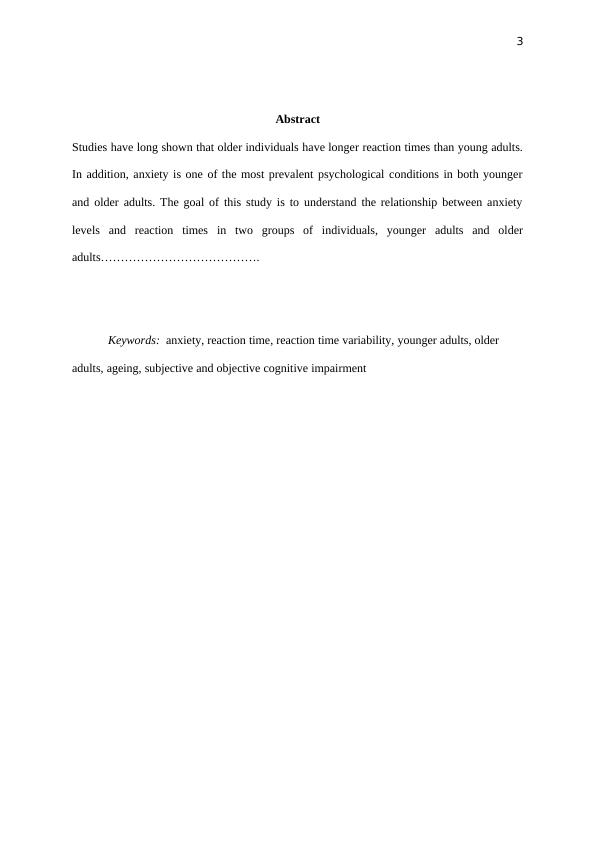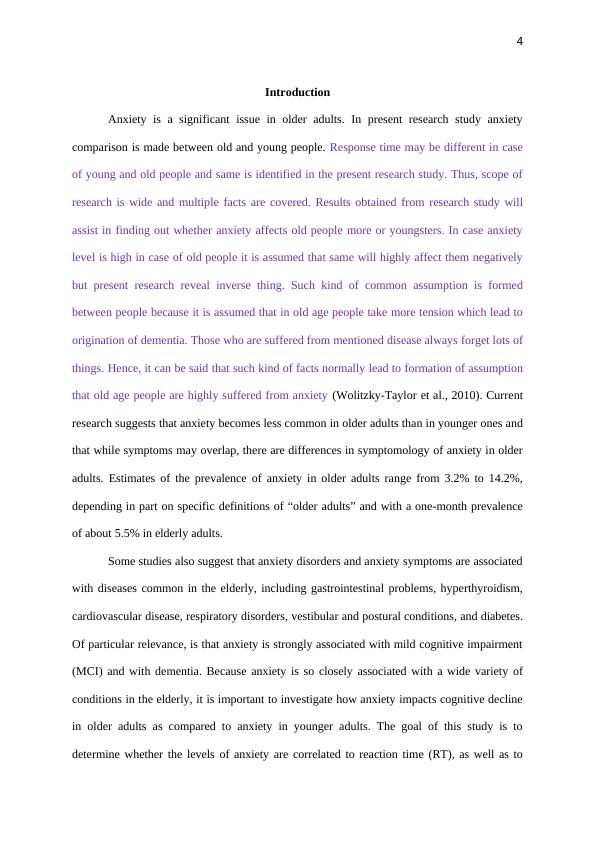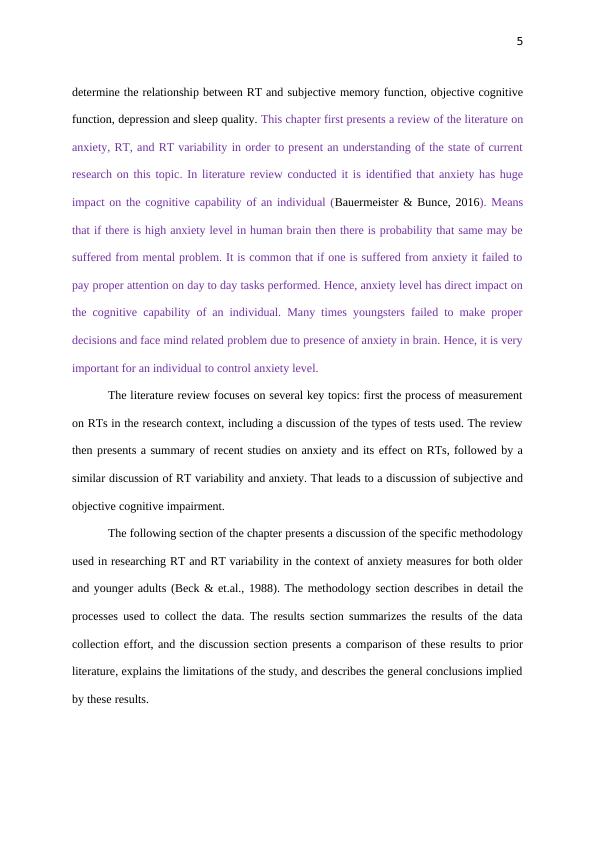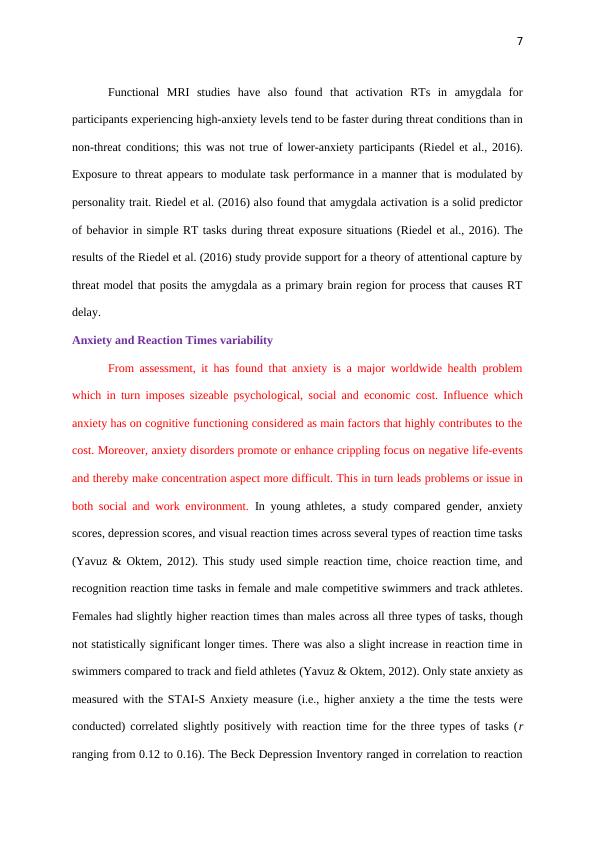Anxiety, Reaction Time, and the Variability of Reaction Time in Younger and Older Adults
Added on 2020-06-06
91 Pages11426 Words49 Views
1
CHAPTER FOUR
CHAPTER FOUR

2
Anxiety, Reaction Time, and the Variability of Reaction Time in Younger and Older
Adults
Anxiety, Reaction Time, and the Variability of Reaction Time in Younger and Older
Adults

3
Abstract
Studies have long shown that older individuals have longer reaction times than young adults.
In addition, anxiety is one of the most prevalent psychological conditions in both younger
and older adults. The goal of this study is to understand the relationship between anxiety
levels and reaction times in two groups of individuals, younger adults and older
adults........................................
Keywords: anxiety, reaction time, reaction time variability, younger adults, older
adults, ageing, subjective and objective cognitive impairment
Abstract
Studies have long shown that older individuals have longer reaction times than young adults.
In addition, anxiety is one of the most prevalent psychological conditions in both younger
and older adults. The goal of this study is to understand the relationship between anxiety
levels and reaction times in two groups of individuals, younger adults and older
adults........................................
Keywords: anxiety, reaction time, reaction time variability, younger adults, older
adults, ageing, subjective and objective cognitive impairment

4
Introduction
Anxiety is a significant issue in older adults. In present research study anxiety
comparison is made between old and young people. Response time may be different in case
of young and old people and same is identified in the present research study. Thus, scope of
research is wide and multiple facts are covered. Results obtained from research study will
assist in finding out whether anxiety affects old people more or youngsters. In case anxiety
level is high in case of old people it is assumed that same will highly affect them negatively
but present research reveal inverse thing. Such kind of common assumption is formed
between people because it is assumed that in old age people take more tension which lead to
origination of dementia. Those who are suffered from mentioned disease always forget lots of
things. Hence, it can be said that such kind of facts normally lead to formation of assumption
that old age people are highly suffered from anxiety (Wolitzky-Taylor et al., 2010). Current
research suggests that anxiety becomes less common in older adults than in younger ones and
that while symptoms may overlap, there are differences in symptomology of anxiety in older
adults. Estimates of the prevalence of anxiety in older adults range from 3.2% to 14.2%,
depending in part on specific definitions of “older adults” and with a one-month prevalence
of about 5.5% in elderly adults.
Some studies also suggest that anxiety disorders and anxiety symptoms are associated
with diseases common in the elderly, including gastrointestinal problems, hyperthyroidism,
cardiovascular disease, respiratory disorders, vestibular and postural conditions, and diabetes.
Of particular relevance, is that anxiety is strongly associated with mild cognitive impairment
(MCI) and with dementia. Because anxiety is so closely associated with a wide variety of
conditions in the elderly, it is important to investigate how anxiety impacts cognitive decline
in older adults as compared to anxiety in younger adults. The goal of this study is to
determine whether the levels of anxiety are correlated to reaction time (RT), as well as to
Introduction
Anxiety is a significant issue in older adults. In present research study anxiety
comparison is made between old and young people. Response time may be different in case
of young and old people and same is identified in the present research study. Thus, scope of
research is wide and multiple facts are covered. Results obtained from research study will
assist in finding out whether anxiety affects old people more or youngsters. In case anxiety
level is high in case of old people it is assumed that same will highly affect them negatively
but present research reveal inverse thing. Such kind of common assumption is formed
between people because it is assumed that in old age people take more tension which lead to
origination of dementia. Those who are suffered from mentioned disease always forget lots of
things. Hence, it can be said that such kind of facts normally lead to formation of assumption
that old age people are highly suffered from anxiety (Wolitzky-Taylor et al., 2010). Current
research suggests that anxiety becomes less common in older adults than in younger ones and
that while symptoms may overlap, there are differences in symptomology of anxiety in older
adults. Estimates of the prevalence of anxiety in older adults range from 3.2% to 14.2%,
depending in part on specific definitions of “older adults” and with a one-month prevalence
of about 5.5% in elderly adults.
Some studies also suggest that anxiety disorders and anxiety symptoms are associated
with diseases common in the elderly, including gastrointestinal problems, hyperthyroidism,
cardiovascular disease, respiratory disorders, vestibular and postural conditions, and diabetes.
Of particular relevance, is that anxiety is strongly associated with mild cognitive impairment
(MCI) and with dementia. Because anxiety is so closely associated with a wide variety of
conditions in the elderly, it is important to investigate how anxiety impacts cognitive decline
in older adults as compared to anxiety in younger adults. The goal of this study is to
determine whether the levels of anxiety are correlated to reaction time (RT), as well as to

5
determine the relationship between RT and subjective memory function, objective cognitive
function, depression and sleep quality. This chapter first presents a review of the literature on
anxiety, RT, and RT variability in order to present an understanding of the state of current
research on this topic. In literature review conducted it is identified that anxiety has huge
impact on the cognitive capability of an individual (Bauermeister & Bunce, 2016). Means
that if there is high anxiety level in human brain then there is probability that same may be
suffered from mental problem. It is common that if one is suffered from anxiety it failed to
pay proper attention on day to day tasks performed. Hence, anxiety level has direct impact on
the cognitive capability of an individual. Many times youngsters failed to make proper
decisions and face mind related problem due to presence of anxiety in brain. Hence, it is very
important for an individual to control anxiety level.
The literature review focuses on several key topics: first the process of measurement
on RTs in the research context, including a discussion of the types of tests used. The review
then presents a summary of recent studies on anxiety and its effect on RTs, followed by a
similar discussion of RT variability and anxiety. That leads to a discussion of subjective and
objective cognitive impairment.
The following section of the chapter presents a discussion of the specific methodology
used in researching RT and RT variability in the context of anxiety measures for both older
and younger adults (Beck & et.al., 1988). The methodology section describes in detail the
processes used to collect the data. The results section summarizes the results of the data
collection effort, and the discussion section presents a comparison of these results to prior
literature, explains the limitations of the study, and describes the general conclusions implied
by these results.
determine the relationship between RT and subjective memory function, objective cognitive
function, depression and sleep quality. This chapter first presents a review of the literature on
anxiety, RT, and RT variability in order to present an understanding of the state of current
research on this topic. In literature review conducted it is identified that anxiety has huge
impact on the cognitive capability of an individual (Bauermeister & Bunce, 2016). Means
that if there is high anxiety level in human brain then there is probability that same may be
suffered from mental problem. It is common that if one is suffered from anxiety it failed to
pay proper attention on day to day tasks performed. Hence, anxiety level has direct impact on
the cognitive capability of an individual. Many times youngsters failed to make proper
decisions and face mind related problem due to presence of anxiety in brain. Hence, it is very
important for an individual to control anxiety level.
The literature review focuses on several key topics: first the process of measurement
on RTs in the research context, including a discussion of the types of tests used. The review
then presents a summary of recent studies on anxiety and its effect on RTs, followed by a
similar discussion of RT variability and anxiety. That leads to a discussion of subjective and
objective cognitive impairment.
The following section of the chapter presents a discussion of the specific methodology
used in researching RT and RT variability in the context of anxiety measures for both older
and younger adults (Beck & et.al., 1988). The methodology section describes in detail the
processes used to collect the data. The results section summarizes the results of the data
collection effort, and the discussion section presents a comparison of these results to prior
literature, explains the limitations of the study, and describes the general conclusions implied
by these results.

6
Literature Review
Neurophysiology of Anxiety
Anxiety is often hypothesized to be due in part to inappropriate regulation of
emotional processing systems in the brain, but the neurobiology of that process is poorly and
incompletely understood. Reaction times in individuals with generalized anxiety disorder
have been found to vary based on the context of individual trials (Etkin et al., 2010).
Functional MRI data taken while participants identified emotional expressions (i.e., “fear” or
“happy”) revealed that the impact of results of prior trials affected only participants with
generalized anxiety disorders (Etkin et al., 2010). Etkin et al. (2010) collected fMRI data
while subjects viewed either congruent images (i.e., a happy face labeled “Happy” or a
fearful face labeled “Fear”) or incongruent images (i.e., a happy face labeled “Fear” or a
fearful face labeled “Happy”). Their data found that healthy subjects had greater activation
responses to incongruent images than subjects with generalized anxiety disorders.
Specifically the areas more highly activated were in the dorsomedial prefrontal cortex (Etkin
et al., 2010). No significant activation differences were found in the pregenual cingulate or
amygdala regions (Etkin et al., 2010). Furthermore, different brain region activations
occurred in the healthy vs. the anxious participants, with a positive correlation between
degree of anxiety and impact on reaction times (Etkin et al., 2010). The researchers
concluded that patients with generalized anxiety disorders both in activating appropriate
control regions, specifically the pregenual cingulate, and deficiencies in the connectivity
needed for the pregenual cingulate to control the limbic structures of the brain (Etkin et al.,
2010). This study highlights the multiple pathways in the brain to process emotional data and
most likely those pathways are primarily controlled without conscious control by the
individual (Etkin et al., 2010).
Literature Review
Neurophysiology of Anxiety
Anxiety is often hypothesized to be due in part to inappropriate regulation of
emotional processing systems in the brain, but the neurobiology of that process is poorly and
incompletely understood. Reaction times in individuals with generalized anxiety disorder
have been found to vary based on the context of individual trials (Etkin et al., 2010).
Functional MRI data taken while participants identified emotional expressions (i.e., “fear” or
“happy”) revealed that the impact of results of prior trials affected only participants with
generalized anxiety disorders (Etkin et al., 2010). Etkin et al. (2010) collected fMRI data
while subjects viewed either congruent images (i.e., a happy face labeled “Happy” or a
fearful face labeled “Fear”) or incongruent images (i.e., a happy face labeled “Fear” or a
fearful face labeled “Happy”). Their data found that healthy subjects had greater activation
responses to incongruent images than subjects with generalized anxiety disorders.
Specifically the areas more highly activated were in the dorsomedial prefrontal cortex (Etkin
et al., 2010). No significant activation differences were found in the pregenual cingulate or
amygdala regions (Etkin et al., 2010). Furthermore, different brain region activations
occurred in the healthy vs. the anxious participants, with a positive correlation between
degree of anxiety and impact on reaction times (Etkin et al., 2010). The researchers
concluded that patients with generalized anxiety disorders both in activating appropriate
control regions, specifically the pregenual cingulate, and deficiencies in the connectivity
needed for the pregenual cingulate to control the limbic structures of the brain (Etkin et al.,
2010). This study highlights the multiple pathways in the brain to process emotional data and
most likely those pathways are primarily controlled without conscious control by the
individual (Etkin et al., 2010).

7
Functional MRI studies have also found that activation RTs in amygdala for
participants experiencing high-anxiety levels tend to be faster during threat conditions than in
non-threat conditions; this was not true of lower-anxiety participants (Riedel et al., 2016).
Exposure to threat appears to modulate task performance in a manner that is modulated by
personality trait. Riedel et al. (2016) also found that amygdala activation is a solid predictor
of behavior in simple RT tasks during threat exposure situations (Riedel et al., 2016). The
results of the Riedel et al. (2016) study provide support for a theory of attentional capture by
threat model that posits the amygdala as a primary brain region for process that causes RT
delay.
Anxiety and Reaction Times variability
From assessment, it has found that anxiety is a major worldwide health problem
which in turn imposes sizeable psychological, social and economic cost. Influence which
anxiety has on cognitive functioning considered as main factors that highly contributes to the
cost. Moreover, anxiety disorders promote or enhance crippling focus on negative life-events
and thereby make concentration aspect more difficult. This in turn leads problems or issue in
both social and work environment. In young athletes, a study compared gender, anxiety
scores, depression scores, and visual reaction times across several types of reaction time tasks
(Yavuz & Oktem, 2012). This study used simple reaction time, choice reaction time, and
recognition reaction time tasks in female and male competitive swimmers and track athletes.
Females had slightly higher reaction times than males across all three types of tasks, though
not statistically significant longer times. There was also a slight increase in reaction time in
swimmers compared to track and field athletes (Yavuz & Oktem, 2012). Only state anxiety as
measured with the STAI-S Anxiety measure (i.e., higher anxiety a the time the tests were
conducted) correlated slightly positively with reaction time for the three types of tasks (r
ranging from 0.12 to 0.16). The Beck Depression Inventory ranged in correlation to reaction
Functional MRI studies have also found that activation RTs in amygdala for
participants experiencing high-anxiety levels tend to be faster during threat conditions than in
non-threat conditions; this was not true of lower-anxiety participants (Riedel et al., 2016).
Exposure to threat appears to modulate task performance in a manner that is modulated by
personality trait. Riedel et al. (2016) also found that amygdala activation is a solid predictor
of behavior in simple RT tasks during threat exposure situations (Riedel et al., 2016). The
results of the Riedel et al. (2016) study provide support for a theory of attentional capture by
threat model that posits the amygdala as a primary brain region for process that causes RT
delay.
Anxiety and Reaction Times variability
From assessment, it has found that anxiety is a major worldwide health problem
which in turn imposes sizeable psychological, social and economic cost. Influence which
anxiety has on cognitive functioning considered as main factors that highly contributes to the
cost. Moreover, anxiety disorders promote or enhance crippling focus on negative life-events
and thereby make concentration aspect more difficult. This in turn leads problems or issue in
both social and work environment. In young athletes, a study compared gender, anxiety
scores, depression scores, and visual reaction times across several types of reaction time tasks
(Yavuz & Oktem, 2012). This study used simple reaction time, choice reaction time, and
recognition reaction time tasks in female and male competitive swimmers and track athletes.
Females had slightly higher reaction times than males across all three types of tasks, though
not statistically significant longer times. There was also a slight increase in reaction time in
swimmers compared to track and field athletes (Yavuz & Oktem, 2012). Only state anxiety as
measured with the STAI-S Anxiety measure (i.e., higher anxiety a the time the tests were
conducted) correlated slightly positively with reaction time for the three types of tasks (r
ranging from 0.12 to 0.16). The Beck Depression Inventory ranged in correlation to reaction

8
times on the three tasks from –0.06 to –0.09. Correlations with the STAI-T Anxiety scale
(i.e., a general tendency for anxiety) ranged from –0.01 to 0.06 (Yavuz & Oktem, 2012). The
greatest correlations were between anxiety and depression, with correlations running 0.53
with the STAI-S Anxiety measure and 0.73 with the STAI-T Anxiety (p < 0.001 in both
cases) (Yavuz & Oktem, 2012).
Relatively few studies have compared anxiety levels in young adults vs. in older
adults with respect to reaction times in cognitive tasks. Fuentes and Cox (2000), however,
compared studies of anxiety with younger adults with those conducted with older
community-dwelling adults to determine age-related differences in how anxiety and
depression presents in these two age groups. Their study had participants self-report using a
number of anxiety and depression instruments. Fuentes and Cox (2000) found no significant
gender differences in the younger adult group across any of the instruments, but gender
differences in older adults appeared with older women more anxious than older men. The
implication of their results was that anxiety presents very similarly between older and
younger adults. Beadreau and O’Hara (2008) found that anxiety in elders impacted cognitive
performance and that cognitively impaired adults experienced a higher degree of anxiety. The
implication of this work is that anxiety can negatively impact reaction times and that older
adults experienced greater impact from anxiety than younger adults.
Anxiety affects more than visual or locomotive tasks. La Buissonniere-Ariza et al.
(2013) tested the RT in highly anxious healthy adults. This small study included 38 healthy
adults who were exposed to an odor detection task and measured for anxiety. Comparing
RTs for pleasant and unpleasant odors for those testing high in anxiety to those testing lower
in anxiety, La Buissonniere-Ariza et al. (2013) found that high-trait anxiety adults had faster
RTs for both types of odors than low-trait anxiety participants. Furthermore, La
times on the three tasks from –0.06 to –0.09. Correlations with the STAI-T Anxiety scale
(i.e., a general tendency for anxiety) ranged from –0.01 to 0.06 (Yavuz & Oktem, 2012). The
greatest correlations were between anxiety and depression, with correlations running 0.53
with the STAI-S Anxiety measure and 0.73 with the STAI-T Anxiety (p < 0.001 in both
cases) (Yavuz & Oktem, 2012).
Relatively few studies have compared anxiety levels in young adults vs. in older
adults with respect to reaction times in cognitive tasks. Fuentes and Cox (2000), however,
compared studies of anxiety with younger adults with those conducted with older
community-dwelling adults to determine age-related differences in how anxiety and
depression presents in these two age groups. Their study had participants self-report using a
number of anxiety and depression instruments. Fuentes and Cox (2000) found no significant
gender differences in the younger adult group across any of the instruments, but gender
differences in older adults appeared with older women more anxious than older men. The
implication of their results was that anxiety presents very similarly between older and
younger adults. Beadreau and O’Hara (2008) found that anxiety in elders impacted cognitive
performance and that cognitively impaired adults experienced a higher degree of anxiety. The
implication of this work is that anxiety can negatively impact reaction times and that older
adults experienced greater impact from anxiety than younger adults.
Anxiety affects more than visual or locomotive tasks. La Buissonniere-Ariza et al.
(2013) tested the RT in highly anxious healthy adults. This small study included 38 healthy
adults who were exposed to an odor detection task and measured for anxiety. Comparing
RTs for pleasant and unpleasant odors for those testing high in anxiety to those testing lower
in anxiety, La Buissonniere-Ariza et al. (2013) found that high-trait anxiety adults had faster
RTs for both types of odors than low-trait anxiety participants. Furthermore, La

End of preview
Want to access all the pages? Upload your documents or become a member.
Related Documents
Anxiety, depression, cognitivity, and cognitive decline among elder adults and younger adultslg...
|35
|15634
|293
Subjective And Objective Cognitive Impairment : Literature Reviewlg...
|60
|18572
|66
Difference in Non-Clinical Anxiety Levels between Young and Older Adults and in Respect to Depression, Cognitive Functions and Demographic Parameterslg...
|34
|10472
|446
(PDF) Anxiety disorders in older adultslg...
|34
|9370
|58
Effects of Sub-clinical Anxiety Levelslg...
|39
|8262
|18
Visual Search and Information Processing Speedlg...
|46
|13333
|304
